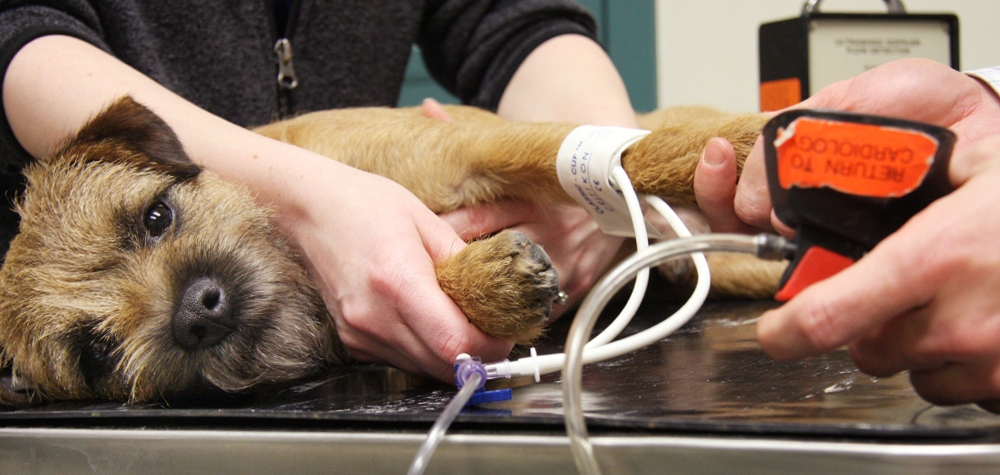What You Required to Find Out About Vet Solutions: A Review of Diagnostic Tools and Procedures
Veterinary solutions play an essential function in keeping the health of family pets. Regular examinations can disclose covert wellness concerns at an early stage. Various diagnostic tools and treatments, such as blood examinations and imaging techniques, offer vital insights right into a pet's wellness. Recognizing these techniques is vital for family pet proprietors. What certain analysis treatments are most generally utilized, and how can they influence an animal's treatment plan?
Significance of Regular Veterinary Exams
While several pet dog proprietors might underestimate the relevance of routine veterinary check-ups, these appointments are essential for maintaining a pet's total health. Routine check outs to the veterinarian permit for very early detection of possible health and wellness concerns prior to they intensify into major problems. Regular exams often consist of vaccinations, which are essential for protecting against contagious diseases that might severely affect a pet's wellness. Additionally, these appointments offer a possibility for veterinarians to assess the pet's weight, dental health and wellness, and overall condition, making sure that the family pet is prospering. Throughout these gos to, pet dog proprietors can additionally obtain valuable advice on diet plan, workout, and preventative care tailored to their details family pet's needs.
Typical Analysis Procedures in Veterinary Medicine
In veterinary medication, exact medical diagnosis is necessary for effective treatment. Usual diagnostic treatments consist of blood screening methods, progressed imaging technologies, and urinalysis, each playing a substantial duty in determining health concerns. Comprehending these techniques enhances the ability to give suitable take care of animal patients.
Blood Testing Techniques
Blood screening techniques function as crucial analysis devices in vet medication, enabling veterinarians to evaluate the wellness of pets properly. These methods include collecting blood examples to evaluate different parts, such as red and white blood cells, platelets, and biochemical pens. Common examinations include complete blood counts (CBC), which review general health and identify infections, and biochemical panels, which analyze organ feature and metabolic condition. Furthermore, serological examinations can identify specific diseases via antibody detection. Blood screening is minimally invasive and provides crucial details that assists in detecting conditions, keeping an eye on health and wellness standing, and reviewing responses to treatments. On the whole, these techniques play a crucial role in guaranteeing optimal take care of pet dogs and animals alike.
Imaging Technologies Utilized
Diagnostic imaging modern technologies are crucial devices in vet medication, matching blood testing methods by giving aesthetic understandings right into an animal's interior frameworks. Usual imaging methods include X-rays, which are valuable for evaluating bone fractures and spotting foreign items, and ultrasound, which permits for real-time visualization of soft cells and organs. Magnetic resonance imaging (MRI) provides comprehensive pictures of intricate physiological areas, especially in neurological evaluations. Computed tomography (CT) supplies cross-sectional images, enhancing diagnostic precision for numerous conditions. Each of these modern technologies aids veterinarians in detecting illnesses, planning therapies, and checking recuperation. By including imaging innovations, vet specialists can better examine a pet's wellness and make educated decisions concerning their care.
Urinalysis and Diagnostics
Urinalysis acts as an essential diagnostic tool in vet medicine, providing useful understandings right into a pet's general health and helping in the discovery of various conditions. This non-invasive procedure examines pee samples to examine kidney function, hydration status, and metabolic problems. Typical elements examined consist of details gravity, pH levels, sugar, proteins, and the visibility of blood or bacteria. Irregular searchings for can indicate concerns such as urinary system tract infections, diabetic issues mellitus, or kidney disease. To boost diagnostic accuracy, urinalysis is commonly done together with various other tests, such as blood job and imaging researches. Early detection with urinalysis can cause timely treatments, enhancing the diagnosis for several vet people. Consequently, it is a vital facet of comprehensive vet treatment.
Comprehending Blood Examinations and Research Laboratory Analysis
Recognizing blood tests and laboratory analysis is important in veterinary medicine as it assists in detecting different wellness conditions in animals. Various kinds of blood tests supply necessary info about a pet's internal state, while translating laboratory results calls for mindful consideration of many factors. This section will certainly discover the kinds of blood examinations offered and the significance of their results.
Types of Blood Tests
Blood examinations play an essential function in vet medicine, supplying vital insights into an animal's health and wellness condition. Numerous kinds of blood examinations are utilized, each serving various objectives. Total blood matters (CBC) evaluate overall health and find problems such as anemia or infection. Biochemical profiles evaluate body organ function by measuring enzymes and electrolytes, using understandings right into metabolic health. Serological tests identify certain antibodies or microorganisms, aiding in the diagnosis of infections or autoimmune conditions. Blood inputting warranties safe transfusions, while coagulation examinations determine the blood's capacity to embolisms, vital for surgeries. These tests collectively boost medical diagnosis, therapy planning, and monitoring of an animal's wellness, showing the relevance of thorough laboratory evaluation in vet care.

Interpreting Lab Results
A comprehensive evaluation of laboratory results is important for accurate diagnosis and treatment in vet medicine. Translating lab results calls for an understanding of normal referral varieties and the value of deviations. Blood tests can expose different wellness indicators, such as organ function, electrolyte equilibrium, and the visibility of infections. Veterinarians must think about the entire scientific picture, consisting of the animal's background, physical exam findings, and any signs and symptoms provided. Variations in outcomes may emerge from factors such as age, breed, and underlying wellness conditions. As a result, lab outcomes must not be seen in isolation but instead as part of a comprehensive diagnostic approach. Exact analysis enables tailored treatment strategies and much better outcomes for vet individuals.
Imaging Techniques: X-rays, Ultrasounds, and Beyond
Imaging methods are important devices in veterinary medicine, supplying essential insights into the health and wellness and health of animals. Among the most generally made use of techniques are Ultrasounds and x-rays. X-rays are important for visualizing bone frameworks, helping vets determine fractures, growths, or foreign things. This method is quick and non-invasive, making it excellent for immediate situations.Ultrasounds, on the various other hand, use acoustic waves to develop images of soft tissues and body organs. This strategy is especially helpful for taking a look at the heart, abdomen, and reproductive body organs, allowing veterinarians to evaluate problems like liquid build-up or organ abnormalities.Beyond X-rays and ultrasounds, advanced imaging strategies such as computed tomography (CT) and magnetic resonance imaging (MRI) are significantly utilized in veterinary method. These approaches supply in-depth cross-sectional images, boosting the precision of diagnoses and therapy strategies. CT Scans For Animals. Generally, imaging methods play an important function in making sure reliable vet care
The Duty of Biopsies in Diagnosing Animal Health Issues
Accuracy in detecting wellness issues in family pets frequently hinges on using biopsies, which offer definitive info regarding cells problems. A biopsy includes the removal of a little sample of cells for assessment under a microscope, allowing vets to identify different problems, including infections, lumps, and inflammatory diseases. This diagnostic device is essential for comparing benign and malignant growths, assisting therapy choices, and reviewing the extent of a condition.Biopsies can be executed making use of different techniques, such as needle desire, incisional biopsies, or excisional biopsies, depending on the location and kind of cells included. The option of method might influence recovery time and the amount of tissue gathered. Inevitably, the details amassed from a biopsy can cause targeted therapies, enhancing outcomes for pets encountering severe health difficulties. Veterinarians emphasize the importance of this procedure in achieving exact medical diagnoses and effective therapy strategies.
Advanced Diagnostic Devices: Endoscopy and CT Checks

Advanced analysis tools, such as endoscopy and CT scans, play an important role in modern-day veterinary medication, using non-invasive methods to imagine internal structures and diagnose different problems in pet dogs. Endoscopy entails the usage of a flexible tube furnished with a Check Out Your URL video camera, allowing vets to analyze the gastrointestinal system and breathing system directly. This technique can reveal irregularities such as lumps, international bodies, or inflammation, allowing targeted therapy plans.CT scans, on the other hand, utilize advanced imaging modern technology to produce comprehensive cross-sectional pictures of the body (Ultrasound For Dogs). This technique is especially valuable for reviewing complex frameworks like the mind, back, and joints. By offering high-resolution pictures, CT scans help veterinarians in recognizing issues that may not appear through traditional radiography. Together, these innovative tools enhance diagnostic accuracy, improve therapy end results, and inevitably add to far better general animal health administration

Analyzing Test Outcomes: What Animal Owners Ought To Know
Recognizing examination outcomes can be a tough task for pet dog owners, especially after innovative procedures like endoscopy and CT scans have actually been executed. Analyzing these outcomes needs a grasp of medical terms and a clear understanding of what the searchings for indicate concerning the pet dog's health and wellness. Veterinarians often offer descriptions, yet the complexity of the outcomes can still lead to confusion.Pet owners need to actively engage in conversations with their veterinarians, asking questions to clarify any type of uncertainties. It is necessary to recognize typical versus abnormal results and the effects for the animal's treatment strategy. In addition, acknowledging that some outcomes may call for further testing or surveillance can help proprietors stay notified about their pet's health and wellness journey. Ultimately, a joint strategy in between pet proprietors and vet specialists promotes much better wellness results and boosts the total care experience for animals.
Regularly Asked Concerns
Exactly how Do I Select the Right Vet Center for My Family pet?
Choosing the best veterinary clinic involves researching local choices, reviewing certifications, visiting centers, and examining personnel communications (CT Scans For Dogs). Prioritizing referrals from relied on sources can assist ensure the very best care and setting for a pet dog's health and wellness requirements
What Should I Do if My Family Pet Declines to visit the Veterinarian?
When an animal declines to visit the veterinarian, it's a good idea to stay tranquil, use treats or playthings to lure them, and take into consideration scheduling a home check out if stress and anxiety continues. Perseverance and favorable reinforcement are essential.
Are There Telehealth Options for Veterinary Providers?
Telehealth alternatives for vet solutions are significantly offered, allowing pet dog owners to seek advice from veterinarians remotely. These solutions allow discussions about wellness issues, suggestions on minor disorders, and follow-ups without requiring to go to a facility.
How Typically Should My Family Pet Have Dental Check-Ups?
The frequency of oral examinations for family pets generally depends on their age and breed. Usually, vets advise yearly dental analyses, although some pets may need even more frequent brows through to preserve perfect oral health and wellness.

What Are the Costs Connected With Vet Diagnostics?
The costs related to vet diagnostics can vary extensively, typically ranging from fundamental tests like blood job to sophisticated imaging methods. Factors affecting expenses include the clinic's area, devices made use of, and certain tests needed for every pet dog. Vet services play an essential function in maintaining the health of family pets. next page While lots of pet dog proprietors might take too lightly the value of routine veterinary check-ups, these consultations are vital for keeping a pet's general health. Furthermore, these appointments offer a possibility for veterinarians to analyze the pet's weight, dental health and wellness, and total problem, making sure that the pet is flourishing. Precision in identifying health concerns in pets commonly pivots on the use of biopsies, which offer conclusive info concerning cells problems. Furthermore, recognizing that from this source some results may call for further testing or surveillance can help owners stay informed concerning their family pet's health and wellness journey.
Comments on “Exploring the Differences Between CT Scans For Dogs and CT Scans For Animals}”